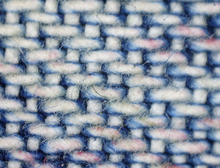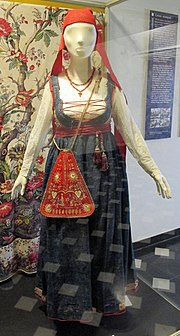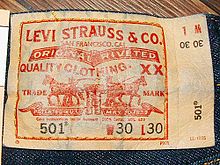
Denim is a sturdy cotton warp-faced textile in which the weft passes under two or more warp threads. This twill weave produces a diagonal ribbing that distinguishes it from cotton duck. Denim, as it is recognized today, was first produced in Nîmes, France.
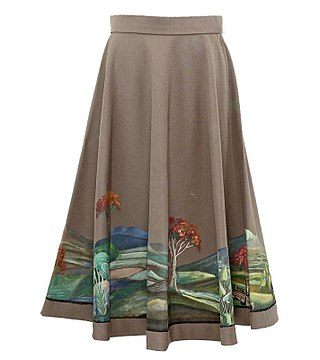
A skirt is the lower part of a dress or a separate outer garment that covers a person from the waist downwards.

Levi Strauss & Co. is an American clothing company known worldwide for its Levi's brand of denim jeans. It was founded in May 1853 when German-Jewish immigrant Levi Strauss moved from Buttenheim, Bavaria, to San Francisco, California, to open a West Coast branch of his brothers' New York dry goods business. Although the corporation is registered in Delaware, the company's corporate headquarters is located in Levi's Plaza in San Francisco.

Overalls or bib-and-brace overalls, also called dungarees in British English, are a type of garment usually used as protective clothing when working. The garments are commonly referred to as a "pair of overalls" by analogy with "pair of trousers".
Wrangler is an American manufacturer of jeans and other clothing items, particularly workwear. The brand is owned by Kontoor Brands Inc., which also owns Lee. Its headquarters is in downtown Greensboro, North Carolina, in the United States, with production plants located throughout the world.

7 For All Mankind is an American denim brand founded by Michael Glasser, Peter Koral, and Jerome Dahan in 2000 and headquartered in Vernon, California. It was purchased by the VF Corporation in 2007 and sold to Delta Galil Industries in 2016.

Western wear is a category of men's and women's clothing which derives its unique style from the clothes worn in the 19th century Wild West. It ranges from accurate historical reproductions of American frontier clothing, to the stylized garments popularized by Western film and television or singing cowboys such as Gene Autry and Roy Rogers in the 1940s and 1950s. It continues to be a fashion choice in the West and Southwestern United States, as well as people associated with country music or Western lifestyles, for example the various Western or Regional Mexican music styles. Western wear typically incorporates one or more of the following: Western shirts with pearl snap fasteners and vaquero design accents, blue jeans, cowboy hat, a leather belt, and cowboy boots.

A denim skirt, sometimes referred to as a 'jean skirt' or 'jeans skirt', is a skirt made of denim, the same material as blue jeans. Denim skirts come in a variety of styles and lengths to suit different populations and occasions. For example, full-length denim skirts are commonly worn by women whose religious beliefs prohibit them from wearing trousers, including Orthodox Jews, some Muslims, Mennonites, and Pentecostals, among others. Shorter skirts made of denim are commonly worn by teenagers and young adults.

Designer clothing is clothing designed by a particular fashion designer or licensed by a person or brand. It is often luxury clothing proven to be high quality and haute couture for the general public, made by, or carrying the label of, a well-known designer. Licensing of designer names has been a common practice within the fashion industry since about the 1970s. Designer clothing comprises numerous types of apparel, including designer jeans that often cost several hundreds of dollars.

Stone washing is a textile manufacturing process used to give a newly manufactured cloth garment a worn appearance. The process became popular in the 1980s, as acid jeans gained popularity; however, stone washing has roots going back to 1960s surfer apparel. Stone washing also helps to increase the softness and flexibility of otherwise stiff and rigid fabrics such as canvas and denim. Although stone washing increases a fabric's flexibility, it shortens the life-span of the jeans. The process of stone washing can be costly, as freshly stone washed jeans must be washed many times in order to remove the grit from the process. Along with high production costs, stone washing can be detrimental to the environment, due to the excess grit that is removed as fabric is being stone washed. This leads many manufacturers to pursue other methods to achieve a distressed appearance.
The Great Western Garment Company (GWG) was a Canadian denim and western wear clothing company founded in 1911 in Edmonton, Alberta by Charles A. Graham and Alexander Cameron Rutherford, the first Premier of Alberta. The company was acquired by Levi Strauss, starting in 1961.

Trousers, slacks, or pants are an item of clothing worn from the waist to anywhere between the knees and the ankles, covering both legs separately. In the United Kingdom, the word pants generally means underwear and not trousers. Shorts are similar to trousers, but with legs that come down only to around the area of the knee, higher or lower depending on the style of the garment. To distinguish them from shorts, trousers may be called "long trousers" in certain contexts such as school uniform, where tailored shorts may be called "short trousers" in the UK.

A denim jacket, also called a jean jacket, jeans jacket or trucker jacket, is a jacket made from denim. Introduced in the United States in the late 19th century, it has been a popular type of casual apparel with both men and women and has been described as an iconic element of American fashion. Though a staple of western wear, the denim jacket has also enjoyed a more general appeal.
Frank Mechaly in Marseille, France and raised in St. Tropez, is a jeans designer and brand maker, specializing in premium denim. Though he has successfully launched a number of brands including Sacred Blue and Blue Cult, he is probably best known as the founder and creator of 575 DENIM which has been embraced by celebrities such as Cameron Diaz who made a point of publicly acknowledging her affinity for the jeans during an appearance on Saturday Night Live. Mechaly has now launched his much-anticipated new brand of premium denim called RockStar.

The 2010s were defined by hipster fashion, athleisure, a revival of austerity-era period pieces and alternative fashions, swag-inspired outfits, 1980s-style neon streetwear, and unisex 1990s-style elements influenced by grunge and skater fashions. The later years of the decade witnessed the growing importance in the western world of social media influencers paid to promote fast fashion brands on Pinterest and Instagram.

Jacob William Davis was a Russian-American tailor of Latvian Jewish origin who is credited with inventing modern jeans. Growing up in Russian Empire, he emigrated to the United States as a young man and spent some time in Canada as well. He invented jeans by using sturdy cloth and rivets to strengthen weak points in the seams, and partnered with Levi Strauss to mass-produce them.

Ian Berry, previously known as Denimu, is a British born artist based in Poplar, East London, who creates artwork solely from denim. Berry re-uses jeans, jackets, and other denim clothing to create portraits, landscapes and other unique works. In 2013, Berry was named as one of Art Business News's "30 under 30" influential artists in the world".

Tilmann Wröbel is a Franco-German fashion designer born in 1964 in Düsseldorf, Germany. He is currently working and living in both Biarritz, France and Düsseldorf, Germany.
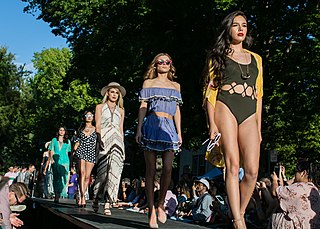
The trickle-up effect in the fashion field, also known as bubble-up pattern, is an innovative fashion theory first described by Paul Blumberg in the 1970s. This effect describes when new trends are found on the streets, showing how innovation flows from the lower class to upper class. It is in contrast with classical theories of fashion consumption, such as those of Georg Simmel and Thorstein Veblen, who theorize that the upper classes are the ones who dictate the fashion flow.
Enzyme washing or "bio stoning" is a textile manufacturing technique in which cellulase enzymes are applied to denim. As with traditional stone washing, the intended effect is a faded appearance and softer feel. Because the technique relies on biotechnology, enzyme washing is considered an example of textile bio-processing.

